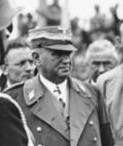Ludwig Siebert
| Ludwig Siebert | |
|---|---|
 | |
| Minister President of Bavaria | |
|
In office 1933–1942 | |
| Preceded by | Heinrich Held |
| Succeeded by | Paul Giesler |
| Personal details | |
| Born |
17 October 1874 Ludwigshafen |
| Died |
1 November 1942 (aged 68) Stock am Chiemsee |
| Nationality | German |
| Political party | National Socialist German Workers' Party (NSDAP) |
| Religion | Lutheranism |
Ludwig Siebert (17 October 1874 in Ludwigshafen – 1 November 1942 in Stock am Chiemsee) was a Nazi politician and Bavarian prime minister from 1933 to 1942.
Life
Siebert was born in Ludwigshafen, in the then Bavarian region of Palatinate, in 1874. He studied law, and after this became a civil servant in the Kingdom of Bavaria. He served as a prosecutor in Neustadt an der Weinstraße, and later in Fürth. Siebert was mayor of Rothenburg ob der Tauber from 1908 to 1919.[1] He afterwards, in 1919,[2] became the mayor of Lindau and while serving in this position in 1931, joined the National Socialist German Workers' Party from the Bavarian People's Party.[3]
He became prime minister of Bavaria in 1933 with the Nazi takeover of power in Germany. As the prime minister of Bavaria, Siebert did not have the power and authority his predecessors had in the Weimar Republic. In this position, he was engaged in a power struggle with the Reichstatthalter of Bavaria, Franz Ritter von Epp, which he won.
In May 1933, Siebert arrived in Passau for the opening of the Ostmarkmuseum.[4]
He also held the posts of Minister of Finances (1933–1942) and for Economy (1933-1934/1936-1942).
He initiated the so-called "Siebert Program" to fight unemployment in Bavaria. The program turned out to be insufficient to create new employment due to lack of funds within the Bavarian government and support from the German government.[5]
Siebert also had personal orders from Hitler to look after the restoration of all castles in Germany and was especially interested in the restoration of the historical town of Rothenburg ob der Tauber from 1937 to 1941.
From 1933 until his death, he was chairman of the board of the Bayerische Berg-, Hütten- und Salzwerke AG (BHS), a large Bavarian mining company.[6] He also served from 1939 to 1942 as the head of the Deutsche Akademie, a predecessor of the Goethe Institut.[7]
His brother was a highly decorated officer in the Wehrmacht, Generalmajor Friedrich Siebert (1888–1950).
Honors
- Honorary citizen of Rothenburg ob der Tauber, alongside Adolf Hitler and Julius Streicher (revoked after the 2nd world war)[8]
- Honorary citizen of Speyer and Augsburg, both revoked after the war.[9]
See also
References
- ↑ Reflections on German Culture and Leitkultur in Rothenburg ob der Tauber author: Joshua Hagen, accessed: 6 May 2008
- ↑ Oberbürgermeister (in German), Historisches Lexikon Bayerns, accessed: 6 May 2008
- ↑ Machtergreifung 1933 – Bayerns "schwarze" Regierung kapituliert (in German), accessed: 6 May 2008
- ↑ Anna Rosmus: Hitlers Nibelungen, Samples Grafenau 2015, pp. 69ff
- ↑ Hitler's Economy: Nazi Work Creation Programs, 1933–1936 google book review, author: Dan P. Silverman, publisher: Harvard University Press, Page 85
- ↑ Bayerische Berg-, Hütten- und Salzwerke AG (BHS) (in German), Historisches Lexikon Bayerns, accessed: 6 May 2008
- ↑ Deutsche Akademie, 1925–1945 (in German), Historisches Lexikon Bayerns, accessed: 6 May 2008
- ↑ Preservation, Tourism and Nationalism: The Jewel of the German Past google book review, author: Joshua Hagen, publisher: Ashgate Publishing, Ltd., page 188
- ↑ Stadt Speyer: Ehrenbürger (in German), accessed: 8 May 2008
External links
- Picture of Ludwig Siebert in Nazi uniform, dated 12 March 1936 Bavarian State Library, Bildarchiv Hoffmann (Heinrich Hoffmann-Verlag)
- Bayrische Staats Bibliothek Datenbank der Reichstagsabgeordneten (in German)
- Universitätsbibliothek Regensburg – Boisls bayrische Biography – Ludwig Siebert (in German), page 726-727
| Political offices | ||
|---|---|---|
| Preceded by Heinrich Held |
Prime Minister of Bavaria 1933–1942 |
Succeeded by Paul Giesler |
.svg.png)